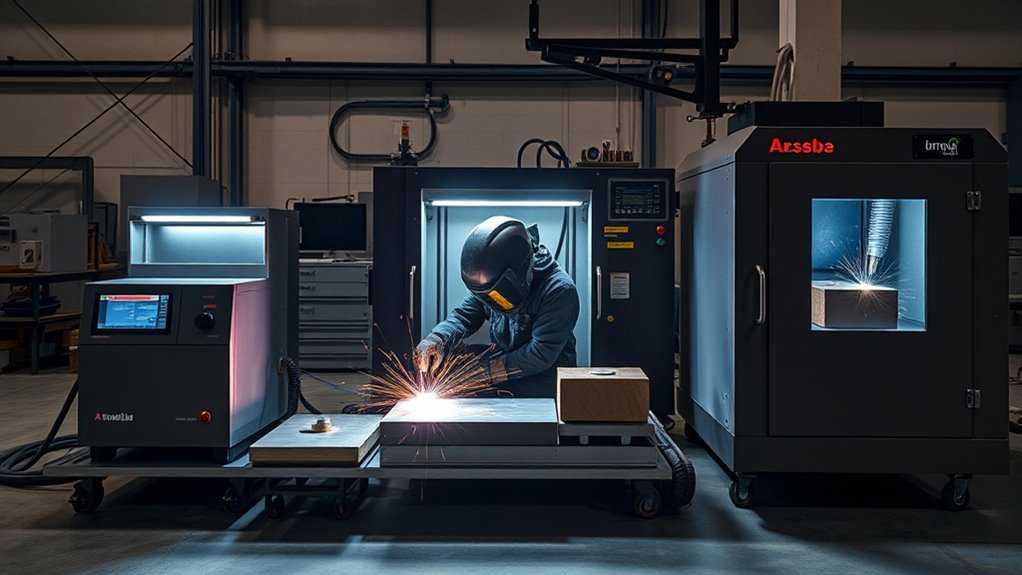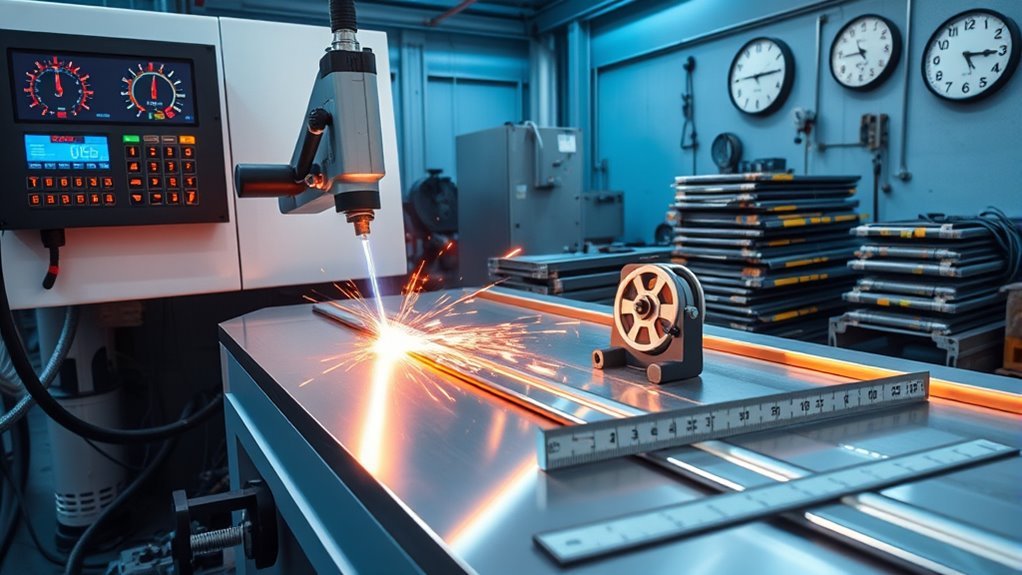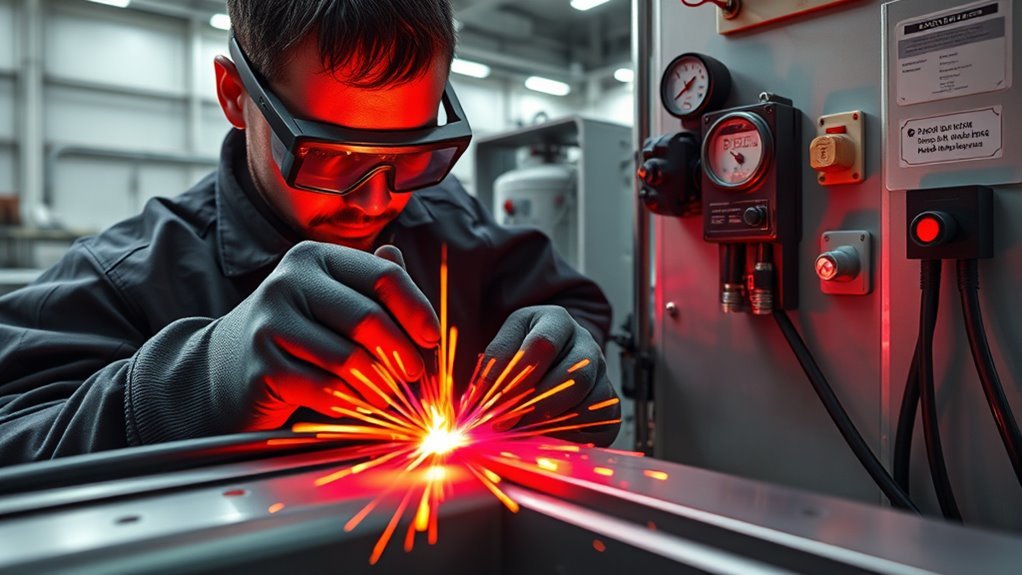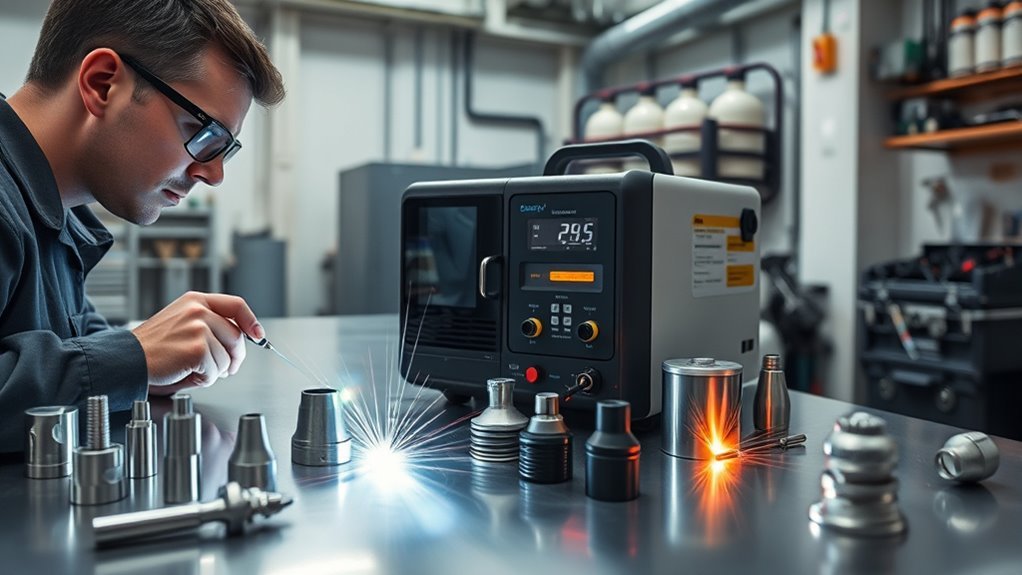If you’re budgeting for laser welding, you need clear numbers and the factors that shift them. Costs hinge on material, thickness, joint type, and machine power, with typical per‑meter and hourly ranges—but there are also maintenance, consumables, and energy costs that often get overlooked. Understand those variables and you’ll see whether buying, leasing, or outsourcing makes sense—and a quick framework will show you how to compare total cost of ownership.
What Determines the Price of Laser Welding

Because different jobs demand different power and precision, the price of laser welding depends primarily on material type and thickness, machine power, and technology.
You’ll see per-meter costs rise from about $0.80 to $2.00 as material thickness increases, because thicker sections need more energy and slower traverse speeds.
Machine power drives hourly rates—typically $50–$150/hour—since higher-power units consume more energy and require robust cooling and controls.
The choice of laser technology (fiber, CO2, Nd:YAG) affects both capital expense and process capability; fiber lasers are efficient for thin-to-medium gauges, while Nd:YAG or CO2 may be chosen for specific metals or geometries.
Initial capital varies widely, from roughly $2,400 for entry-level rigs to $15,000+ for commercial systems, and that influences amortized part costs.
Don’t forget ongoing factors: maintenance, consumables, and energy consumption materially raise total cost of ownership and should be included when you calculate per-part or per-meter pricing.
Typical Price Ranges by Machine Type and Power

When you shop for laser welding equipment, expect prices to climb with power and capability: entry-level 1,000W units run around $2,400, 1,500W models typically fall between $2,800 and $5,200, mid-range 2,000W systems cost about $3,600–$7,800, 3,000W commercial machines are commonly $5,000–$9,500, and advanced 6,000W platforms start near $15,000.
You’ll choose based on part volume, material thickness, and required throughput. Compare machine features such as beam quality, pulse control, and automation options; these drive step changes in price more than nominal wattage alone.
Consider power efficiency ratings and cooling requirements since higher efficiency reduces operating overhead and may justify a higher capital outlay. For small shops, 1,000–1,500W systems deliver adequate capability at low cost.
Mid-size shops often prefer 2,000–3,000W for versatility. Industrial users needing penetration and cycle speed opt for 6,000W platforms. Budget to align purchase price with long-term productivity gains, not just peak power numbers.
Cost per Meter and Hourly Pricing Explained

A clear way to budget for laser welding is to look at both cost-per-meter and hourly rates, since you’ll often choose by part geometry and production rhythm rather than just machine wattage. You’ll see cost-per-meter tied to material thickness and type: roughly $0.80/m for 1mm steel up to $2.00/m for 6mm steel. Use per-meter when length dominates job costing; use hourly when setups, fixturing, or low throughput dominate.
| Metric | Range | Typical driver |
|---|---|---|
| Cost per meter | $0.80 – $2.00 | material thickness, weld length |
| Hourly rate (≤1500W) | $50 – $80 | lower machine power |
| Hourly rate (1500–3000W) | $100 – $150 | higher machine power |
To choose, calculate both: multiply length by $/m and compare to estimated machine-hours × $/hr. This highlights which factor—material thickness, cycle time, or machine power—dominates cost so you can optimize quoting and production planning.
Hidden and Ongoing Expenses to Budget For

You’ll want to look beyond per-meter and hourly figures to capture the ongoing costs that quietly shape your true weld price. Hidden expenses include regular maintenance—typically $1,000–$5,000 per year—plus consumables (shielding gas, wear parts) adding $500–$2,000 annually depending on throughput.
Look beyond per-meter rates: factor in maintenance, consumables, energy, and training to reveal the true weld cost.
Energy is another measurable ongoing cost: a 1000W laser typically consumes power that costs $1.50–$3.00 per operating hour. You’ll also need to budget operator training at roughly $2,000–$5,000 per person for safe, efficient use of complex systems.
Track these line items on a per-shift or per-job basis to avoid underpricing. Combine scheduled maintenance, spare-part stocking, gas usage rates, and training amortization to generate realistic job quotes.
Exclude resale depreciation from immediate operational budgets, but be aware it affects long-term financial planning. Being precise about hidden expenses and ongoing costs prevents margin erosion and supports consistent pricing decisions.
Calculating Total Cost of Ownership and ROI

Because total cost of ownership (TCO) combines purchase price, operating expenses, maintenance, training, and resale loss, you should quantify each component over a defined period (typically 3–5 years) to calculate true cost per hour or per part.
Start with the capital outlay, subtract projected resale (15%–20% of purchase after five years), then add cumulative operating costs: energy and consumables ($1.5–$3.0/hour for a 1,000W unit plus annual consumables $500–$2,000).
Include scheduled maintenance and unplanned repairs (thousands annually) and training/labor ($2,000–$5,000 per operator).
- Annualize capital minus resale to get yearly depreciation and combine with fixed maintenance and training.
- Divide total annual expense by productive hours to derive cost per hour; compare to part throughput for cost per part.
- Run an investment analysis comparing TCO-adjusted cost per part against alternative processes, factoring material savings from reduced rework to estimate payback and ROI.
Tips to Reduce Purchase and Operating Costs

When evaluating purchase and operating costs, focus on matching machine capability to your production needs so you don’t overpay for unused power or features; entry-level welders start around $2,400 while high‑power units can exceed $15,000, so choose the lowest‑cost model that meets throughput, duty cycle, and material requirements.
Prioritize machine selection by appraising duty cycle, beam quality, and energy efficiency—1000W units typically consume $1.5–$3.0 per hour—so higher-efficiency models reduce operating costs. Negotiate pricing, lease, or finance to spread capital expenditure and improve cash flow. Favor multi‑function combo machines to avoid buying separate equipment.
Implement formal maintenance strategies: scheduled inspections, consumable tracking, and operator training to prevent unplanned downtime and costly repairs. Budget for hidden costs—consumables and training can total $2,000–$5,000 per operator—and factor them into total cost of ownership.
Monitor energy use and uptime metrics to validate ROI and adjust procurement or maintenance plans accordingly.
Frequently Asked Questions
What Safety Certifications Are Required for Operating Laser Welding Equipment?
You need laser safety officer certification (ANSI Z136.1/IEC 60825), OSHA training, and site-specific permits; you’ll follow safety standards, PPE protocols, and documented equipment maintenance procedures, plus periodic competency recertification and hazard assessments.
Can Laser Welding Be Used on Aluminum or Other Non-Ferrous Metals?
Yes — you can laser weld aluminum and other non‑ferrous metals; you’ll exploit aluminum applications like heat‑sensitive joints, controlling focus and pulse to manage reflectivity, achieving non ferrous benefits: low distortion, narrow HAZ, precise, repeatable welds.
How Long Is the Typical Warranty for Laser Welding Systems?
You’ll typically get a 12–36 month warranty duration; manufacturers usually specify warranty coverage for parts, labor, and optics, though consumables and misuse are excluded — check terms closely to avoid unexpected service costs.
Do Portable/Handheld Laser Welders Require Special Licensing?
You typically do need licensing or certification: portable welder regulations and handheld welder requirements often mandate operator training, eye/skin protection, electrical permits, and workplace safety compliance, so check local codes and manufacturer recommendations before operating.
What Training or Certification Do Operators Need to Run Laser Welders?
You need formal operator skills training and often completion of certification programs (e.g., AWF, vendor-specific) covering laser safety, process control, optics, and material metallurgy; hands-on assessments and periodic recertification are typically required.
Conclusion
You now know the key drivers of laser-welding cost — material, thickness, and machine power — and typical per‑meter ($0.80–$2.00) and hourly ($50–$150) ranges. Don’t forget maintenance, consumables, and energy, which quietly multiply expenses. Calculate total cost of ownership and ROI before buying so you won’t be surprised by runaway bills. Use higher-efficiency lasers, preventive maintenance, and volume pricing to cut operating costs and speed payback — it’s money very well spent.


